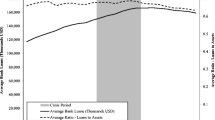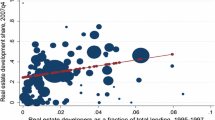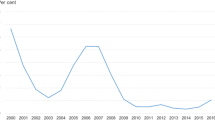Abstract
This paper examines the evolution of intra-financial sector lending in the United States, 1950–2012, constructing estimates from the Federal Reserve’s Flow of Funds Accounts. Lending between financial institutions has grown nearly five-fold since the 1950s and currently accounts for roughly half of all financial sector lending. In the run up to the financial crisis of 2007–2008, the growth of intra-financial lending was concentrated in assets highly implicated in the genesis of the crisis, suggesting that this growth may have contributed to the crisis. This growth in intra-financial lending also raises questions about the contribution of the financial sector to the real economy.







Similar content being viewed by others
Notes
Yellen [2013].
See also D’Arista and Epstein [2010] and Pozsar et al. [2010].
This literature is surveyed in Allen and Babus [2009]. Other early contributions are Freixas et al. [2000] and Dasgupta [2004].
In keeping with the literature and the Federal Reserve’s definition, we will refer to claims between financial institutions but within the financial sector as “intra-financial sector lending.” We will also refer to this interchangeably as simply “intra-financial lending.”
We will refer to data from the FR Y-15 report below as a robustness check on our own estimates.
Bhatia and Bayoumi limited their analysis to asset stocks.
See the data appendix for more detail.
See the appendix for a more detailed explanation.
See Table A5 in the appendix for a description of the instrument series.
For a detailed explanation of how FoF series codes are structured see the FoF’s online guide at: http://www.federalreserve.gov/apps/fof/SeriesStructure.aspx.
This was ascertained through private correspondences with economists at the Flow of Funds division of the Federal Reserve.
References
Acemoglu, Daron, Asuman Ozdaglar, and Alireza Tahbaz-Salehi. 2013. Systemic Risk and Stability in Financial Networks. Technical Report, National Bureau of Economic Research, http://www.nber.org/papers/w18727.
Allen, Franklin, and Ana Babus. 2009. Networks in Finance, in The Network Challenge: Strategy, Profit, and Risk in an Interlinked World,, edited by Yoram Wind, Paul R Kleindorfer and Robert E. Gunther Upper Saddle River, NJ: Wharton School Publishing, 367–379.
Allen, Franklin, and Douglas Gale. 2000. Financial Contagion. The Journal of Political Economy, 108(1): 1–33.
Arcand, Jean-Louis, Enrico Berkes, and Ugo Panizza. 2012. Too Much Finance? IMF Working Paper, No. 161. Washington DC: International Monetary Fund.
Bezemer, Dirk. 2012. Finance and Growth: When Credit Helps, and When it Hinders. Berlin: Institute for New Economic Thinking.
Basel Committee on Banking Supervision. 2011. Global Systemically Important Banks: Assessment Methodology and the Additional Loss Absorbency Requirement. Technical Report. Basel, Switzerland: Bank for International Settlements.
Bhatia, Ashok Vir, and Tamim Bayoumi. 2012. Leverage? What Leverage? A Deep Dive into the US Flow of Funds in Search of Clues to the Global Crisis. IMF Working Papers, No. 162. Washington DC: International Monetary Fund.
D’Arista, Jane. 2009. Rebuilding the Framework for Financial Regulation. Technical Report 231. Washington DC. Economic Policy Institute, May.
D’Arista, Jane, and Gerald Epstein. 2010. Dodd-Frank and the Regulation of Dangerous Financial Inter-Connectedness, in Will It Work? How Will We Know? The Future of Financial Reform, edited by Mike Konczal. New York: The Roosevelt Institute.
Dasgupta, Amil. 2004. Financial Contagion through Capital Connections: A Model of the Origin and Spread of Bank Panics. Journal of the European Economic Association, 2(6): 1049–1084.
Epstein, Gerald, and James Crotty. 2012. How Big is Too Big?: On the Social Efficiency of the Financial Sector in the United States. in Capitalism on Trial: Explorations in the Tradition of Thomas E. Weisskopf. edited by Jeanette Wicks-Lim and Robert Pollin. Northampton, MA: E. Elgar Publisher, 293–310.
Freixas, Xavier, Bruno M. Parigi, and Jean-Charles Rochet. 2000. Systemic Risk, Interbank Relations, and Liquidity Provision by the Central Bank. Journal of Money, Credit, and Banking, 32(3): 611–638.
Gai, Prasanna, Andrew Haldane, and Sujit Kapadia. 2011. Complexity, Concentration and Contagion. Journal of Monetary Economics, 58(5): 453–470.
Gorton, Gary, and Andrew Metrick. 2009. The Run on Repo and the Panic of 2007–2008. Unpublished paper, Yale University.
Greenwood, Robin, and David Scharfstein. 2013. The Growth of Finance. Journal of Economic Perspectives, 27(2): 3–28.
Montecino, Juan Antonio, and Gerald Epstein. 2014. Intra-Financial Lending, Credit, and Capital Formation. PERI Working Paper. Amherst, MA: Political Economy Research Institute.
Philippon, Thomas. 2012. Has the US Finance Industry Become Less Efficient? On the Theory and Measurement of Financial Intermediation. Technical Report, National Bureau of Economic Research, http://www.nber.org/papers/w18077.
Pozsar, Zoltan, Tobias Adrian, Adam Ashcraft, and Hayley Boesky. 2010. Shadow Banking. Technical Report 458. New York: Federal Reserve Bank of New York, July.
Shin, Hyun. 2010. Financial Intermediation and the Post-Crisis Financial System. Bank for International Settlements, BIS Working Papers No. 381, http://papers.ssrn.com/sol3/papers.cfm?abstract_id=2117753.
The Times 2009. “Wake Up, Gentlemen”, World’s Top Bankers Warned by Former Fed Chairman Volcker. London: LexisNexis Academic.
Turner, Adair. 2010. What Do Banks Do? Why Do Credit Booms and Busts Occur and What Can Public Policy Do About it? Technical Report, London School of Economics, London, http://innovbfa.viabloga.com/files/LSE___the_future_of_finance___aug_2010_1.pdf#page=9.
Upper, Christian. 2011. Simulation Methods to Assess the Danger of Contagion in Interbank Markets. Journal of Financial Stability, 7(3): 111–125.
Yellen, Janet L. 2003. Interconnectedness and systemic risk: Lessons from the financial crisis and policy implications. American Economic Association/American Finance Association Joint Luncheon.
Acknowledgements
The authors thank the Institute for New Economic Thinking (INET) for financial support and participants in workshops at the University of Massachusetts, Amherst and the New School for Social Research for helpful comments.
Author information
Authors and Affiliations
Corresponding author
Appendix
Appendix
Data appendix
As explained above, we assume that a share α of each type of financial sector asset translates into liabilities for the financial sector. The share α is estimated as follows: let l i f and L i be the liabilities of instrument i held, respectively, by the financial sector and all sectors combined. The share α of each instrument i is simply l i f /L i . α’s are calculated for each year.
Table A3 shows the FoF code for each series used to calculate the baseline α shares (i.e., those that include the Federal Reserve).Footnote 11 For instance, the α for open market paper is calculated as:

In order to remove the Federal Reserve from checkable deposits and currency, we calculate a separate α for Federal Reserve liabilities. This α equals

The amount of intra-financial assets of checkable deposits and currency were thus calculated as

In the case of net inter-bank transactions and federal funds and repurchase agreements it was possible to identify and therefore directly subtract Federal Reserve assets and liabilities from financial sector asset stocks and lending flows in both instrument categories. This is necessary in order to avoid counting lending by the Federal Reserve as well as lending to the Federal Reserve. For net interbank transactions, we subtract Federal Reserve assets in this category (FL714010005), which include floats and loans to domestic banks; and also subtract Federal Reserve liabilities (FL714110005), which include depository institutions’ reserves and vault cash. For federal fund and repurchase agreements, we subtract the Federal Reserve’s reverse repurchase agreements (FL712150003) from total financial sector assets (Table A4).
Table A5 presents the underlying series used for the calculation of intra-financial assets and lending for each instrument category. For instance, the total assets of the instrument category agency and GSE-backed securities is calculated as the sum of these instruments held by the sub-sector series including US-chartered depositary institutions (FA763061705), mutual funds (FA653061703), issuers of asset-backed securities (FA673061705), and so on. Detailed descriptions of each series are available in the FoF online guide (http://www.federalreserve.gov/apps/fof/) by searching for the appropriate series code.
It is worth mentioning one aspect of how the instrument categories are organized. In cases when types of instruments have been securitized, the broad instrument categories include both the underlying class of asset as well as the securitized product.Footnote 12 For instance, the other loans and advances category includes both collateralized loan obligations and the underlying business loans these are based on. Similarly, the agency and GSE-backed securities category includes both the original mortgage pools as well as the resulting mortgage- backed securities. In these instances we take care to only count the instrument sub-categories that result in intra-financial claims and not those that evidently represent claims on other sectors, for example, households or non-financial business (Tables A6 and A7).
Rights and permissions
About this article
Cite this article
Montecino, J., Epstein, G. & Levina, I. Long-Term Trends in Intra-Financial Sector Lending in the United States (1950–2012). Eastern Econ J 42, 611–629 (2016). https://doi.org/10.1057/eej.2015.1
Published:
Issue Date:
DOI: https://doi.org/10.1057/eej.2015.1





